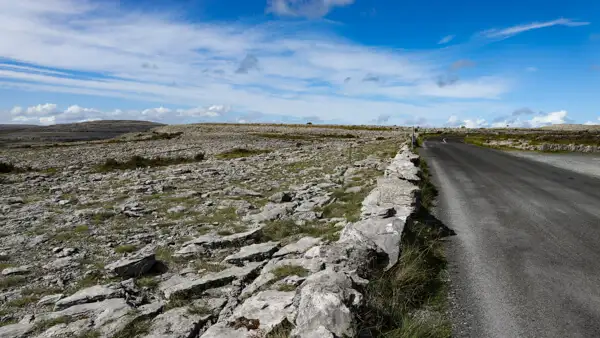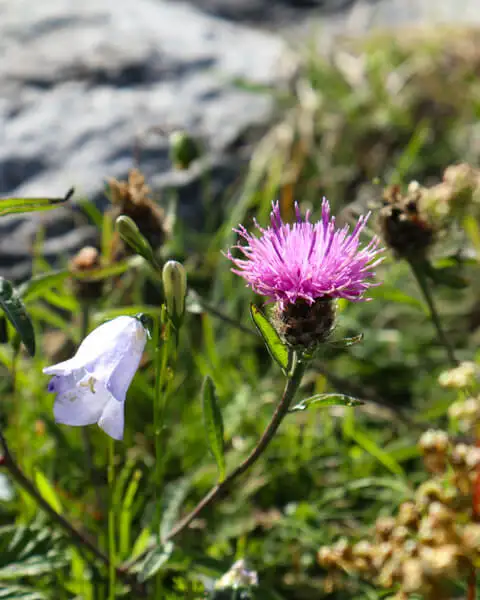Hilly, incredibly green countryside with lots of sheep pastures and hedgerows – this is what a typical Irish landscape should look like. The Burren, however, does not correspond to this image at all….
Page Contents (click line to jump the text)

Intro
“There were lots of stones but not much bread” would be a fitting description for this landscape on the west coast of Ireland.
The British General Edmund Ludlow, who laboured here in the middle of the 17th century to capture small groups of Irish rebels, put it even more dramatically: “It is a country where there is not enough water to drown a man, wood enough to hang one, nor earth enough to bury him.”
Today, rebels are no longer hunted in the Burren and so we visitors can enjoy this unique landscape in a carefree and unhurried manner.
But what is there to enjoy?
The rocks and hills are uniquely shaped and quite beautiful to look at. The rocky ground is furrowed by water erosion and flowers and plants of all kinds grow in these furrows. Some of the fauna and flora on the Burren are unique on the island.

The Burren therefore offers much more life than General Ludlow realised in the 17th century, but biodiversity was probably not his most important concern back then either…
Then there is the beautiful coastal road that runs along the Burren. The rocky hills of the Burren on one side, the open sea on the other – what more could you want?
And then there are several sights – but more on that later.
I’ve been to the Burren several times myself and am always fascinated by this small but beautiful national park on the Wild Atlantic Way.
We have been living in Ireland, south of Dublin (second home), for several years. We are originally from Germany. We have travelled a lot on the Irish island and know it very well.
But let’s get back to the Burren:
The Burren – some background
The Burren is a unique landscape on the west coast of Ireland. It lies between Galway Bay and the Cliffs of Moher. Together with these, it forms a joint geopark. See also: https://www.burrengeopark.ie/.
The karstic low mountain range is over 330 million years old and consists mainly of limestone and calcareous sandstone. This was originally seabed and sediments and limestone alternated to form thick layers.

Uplifting of the seabed and lowering of the sea level finally exposed the seabed. Today, the various layers of rock are visible in more or less diagonal stripes in the hills of the Burren. Numerous marine fossils, such as starfish and corals, can be found in the rock.
Erosion by rainwater has led to the formation of fissures and furrows in the rock and also to the formation of stalactite caves deep underground. The most famous of these are Ailwee Cave and Doolin Cave, which you can also visit.

Mining was carried out in the region until the middle of the 20th century. Mainly phosphate for fertiliser production, calcite for cement production, but also lead, silver and copper. Like everywhere else in the country, however, mining gradually ceased.
The region protected today was not always so barren, but was used intensively for agriculture over 5000 years ago. Numerous remnants of the settlers of that time, such as dolmens, ring forts and the remains of dwellings, can still be found all over the Burren today. One example is the Poulnabrone Dolmen, which I will come back to later.
Overgrazing and erosion led to the barren landscape we see today, where mainly scrub, grasses, mosses and lichens thrive, but also many rarer plants and even orchids. Some of them are otherwise only found in arctic regions or in the Alps.

The fauna has adapted to the sparse habitat. There are numerous species of insects, such as butterflies, but also plenty of land and sea birds, salamanders and smaller mammals. Deer occasionally pass through this region but more often you will see feral domestic goats, which are now found wild throughout Ireland in the mountainous regions.
Topsoil collects and forms in the narrow furrows in the rocky ground, providing a home for an amazing variety of flowers, shrubs and grasses. Plants grow here that cannot be found anywhere else in Ireland. And where diverse plants flourish, diverse insects, amphibians and birds also thrive.
The Ailwee Cave
Ailwee Cave is one of the oldest caves in Ireland. You can visit it on a highly recommended tour. The cave is easily accessible and the tour doesn’t take too long – it definitely fits well into your itinerary.
There are many stalactites and stalagmites to see and a particular highlight are the remains of a cave bear, or rather brown bear, which lived here over 10,000 years ago.
There is also a falconry with flight demonstrations and a farm shop. See: https://aillweeburrenexperience.ie/.

The Poulnabrone Dolmen
The Poulnabrone Dolmen is just up the road from Ailwee Cave. It is one of the best preserved portal stones or portal tombs in Ireland.
The dolmen is well over 5000 years old, making it probably the oldest dolmen in Ireland. The significance of dolmens in Ireland is not always clear, but the Poulnabrone Dolmen apparently served as a burial site, as the remains of 22 people were found here, some of whose DNA still shows similarities with modern people in the region.
Other finds included axes, arrowheads, scrapers and jewellery stones, which were apparently grave goods and tell us today about the life of the Neolithic settlers in Ireland.
The small car park and the dolmen are freely accessible and there are informative display boards on the site. See also: https://irisharchaeology.org/poulnabrone-dolmen/.

What else you can see in the area
The Burren also offers one of the most beautiful coastal roads in the region, the R477 from Ballyryan to Ballyvaughan. On this section, the road mostly runs very close to the sea and at Black Head Lighthouse you drive along the coast directly above the surf.
Dunguaire Castle
In the north of the Burren, near Kinvara, there is a small castle on a rock. This is washed by the sea at high tide, but at low tide, Dunguaire Castle is largely on dry land. The castle is well preserved and it is worth taking a short break to walk around it and see the castle courtyard. There are also guided tours of the Keep, the castle’s residential tower. See: https://www.dunguairecastle.com/.
Fanore Beach
Fanore Beach is a large sandy beach with sand dunes. It is not located directly at Fanore, but a little further north, in the direction of Murroogh. The beach is popular with surfers and swimmers and is worth a short break or a walk on the beach.

The Doolin Cave
There are several stalactite caves under the Burren. In addition to Ailwee Cave, you can also visit Doolin Cave and take a guided tour underground. Here you will also find the 7 metre long and therefore longest stalactites in Europe See: https://doolincave.ie/.
Hiking on the Burren Way
Are you a hiking enthusiast? The Burren Way is one of over 43 long-distance hiking trails in Ireland. It includes the Burren and the Cliff Walk at the Cliffs of Moher. See also my articles on this: https://ireland-insider.com/the-burren-way/.
The Cliffs of Moher
The Cliffs of Moher stand over 200 metres high, almost vertically above the wild Atlantic Ocean. Together with the Burren, they belong to a geopark and are a must-see for travellers on the Wild Atlantic Way. See also my article on the subject: https://ireland-insider.com/the-famous-cliffs-of-moher/.
Conclusion
If you are travelling along the west coast of Ireland, the Wild Atlantic Way, and have just arrived from Galway or are on your way there, then don’t drive past the Burren carelessly.
Take your time, enjoy the beautiful coastal road, take a detour over the mountains, visit Ailwee Cave, Poulnabrone Dolmen and Dunguaire Castle and take in this unique Irish landscape.
You may also want to go for a short hike, or even walk the Burren Way.
However you prefer to travel – I wish you lots of fun in the Burren!
More interesting articles for you
THE CLIFFS OF SLIEVE LEAGUE – MAJESTIC AND MARVELLOUS
DROMBEG STONE CIRCLE – THE MEGALITHIC HERITAGE OF IRELAND
POWERSCOURT HOUSE AND GARDENS
THE LEGENDARY ROCK OF CASHEL
Picture credits cover picture: Poulnabrone Dolmen at the Burren, photo: Ulrich Knüppel-Gertberg (www.irland-insider.de, www.ireland-insider.com)